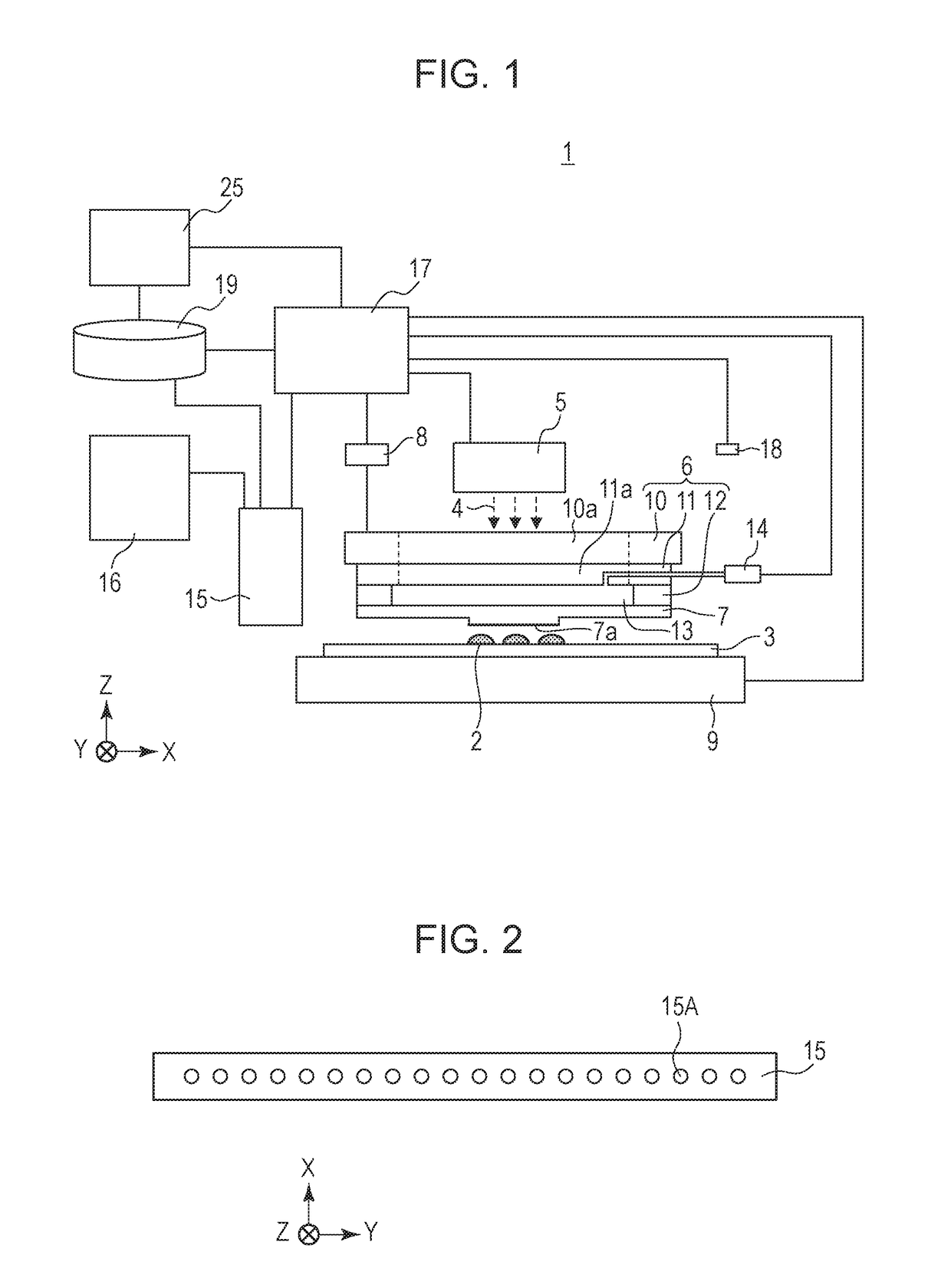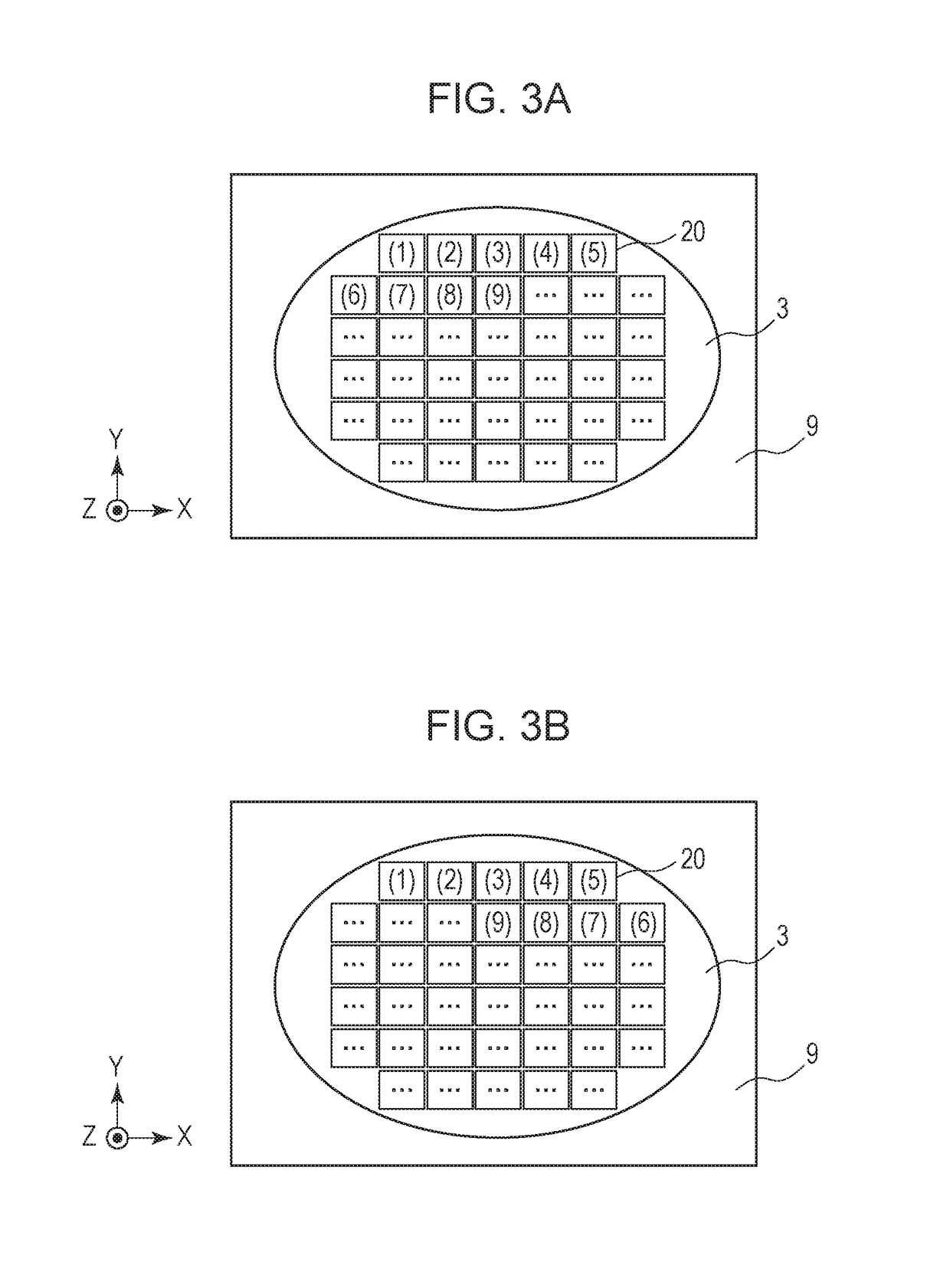Imprinting apparatus, imprinting method, and article manufacturing method
a technology of imprinting apparatus and imprinting method, which is applied in the direction of instruments, photomechanical treatment, optics, etc., can solve the problems of articles not showing desired performance, and achieve the effect of reducing the thickness of the residual layer and reducing the uniformity of the residual layer
- Summary
- Abstract
- Description
- Claims
- Application Information
AI Technical Summary
Benefits of technology
Problems solved by technology
Method used
Image
Examples
first embodiment
(Configuration of Apparatus)
[0026]FIG. 1 illustrates an imprinting apparatus 1 according to a first embodiment of the present invention. Referring to FIG. 1, a substrate stage 9 carries a substrate 3 such as a wafer and moves along a horizontal plane. The term “horizontal plane” refers to a plane that is perpendicular to the direction of gravitational force. The phrase “to move along the horizontal plane” encompasses a case where the substrate stage 9 moves while inclining with respect to the horizontal plane by a small angle within a range of control error that may occur when the substrate stage 9 is driven. In the first embodiment, a term “information related to the state of imprint material” refers to likely nonuniformity in the thickness of a residual layer 2b (see FIGS. 6A to 6D) included in a pattern formed of imprint material that is estimated from the direction of movement of the substrate stage 9 (the information is hereinafter referred to as “likely residual-layer informat...
second embodiment
[0061]In a second embodiment of the present invention, the degree of inclination of the substrate stage 9 is acquired from the current for controlling a motor of the substrate stage 9 (hereinafter also referred to as “stage controlling current”). The stage controlling current also correlates with the direction of movement of the substrate stage 9 and the level of the force for moving the substrate stage 9. The direction of inclination of the plane at the top of the imprint material 2 according to the second embodiment corresponds to, for example, the direction of inclination of the substrate stage 9, as in the first embodiment.
[0062]FIG. 9 is a graph illustrating a relationship between the positional deviation of the substrate stage 9 and the current for controlling the substrate stage 9. The horizontal axis represents time, and the vertical axis represents the instructed position of the substrate stage 9 (the solid line), the positional deviation of the substrate stage 9 from the i...
third embodiment
[0064]In a third embodiment of the present invention, the likely residual-layer information is acquired on the basis of the direction of movement of the substrate stage 9 and information related to surface irregularities (the flatness) of the substrate 3 (irregularity information). If the substrate 3 is not flat as illustrated in FIG. 10A, the plane at the top of the imprint material 2 does not become flat, conforming to the shape of the substrate 3. Hence, the control unit 17 causes the measuring device 18 to measure surface positions of the substrate 3 with respect to the measuring device 18 and thus acquires information related to surface irregularities of the substrate 3.
[0065]FIG. 10B illustrates an exemplary control method. If the substrate stage 9 is at an angle θs with respect to the horizontal plane and a shot area 20 of interest on the substrate 3 is at an angle −θw with respect to the substrate stage 9, the mold 7 is inclined with respect to the horizontal plane by an ang...
PUM
| Property | Measurement | Unit |
|---|---|---|
| relative angle | aaaaa | aaaaa |
| speed | aaaaa | aaaaa |
| area | aaaaa | aaaaa |
Abstract
Description
Claims
Application Information
 Login to View More
Login to View More - R&D
- Intellectual Property
- Life Sciences
- Materials
- Tech Scout
- Unparalleled Data Quality
- Higher Quality Content
- 60% Fewer Hallucinations
Browse by: Latest US Patents, China's latest patents, Technical Efficacy Thesaurus, Application Domain, Technology Topic, Popular Technical Reports.
© 2025 PatSnap. All rights reserved.Legal|Privacy policy|Modern Slavery Act Transparency Statement|Sitemap|About US| Contact US: help@patsnap.com



